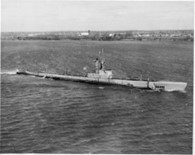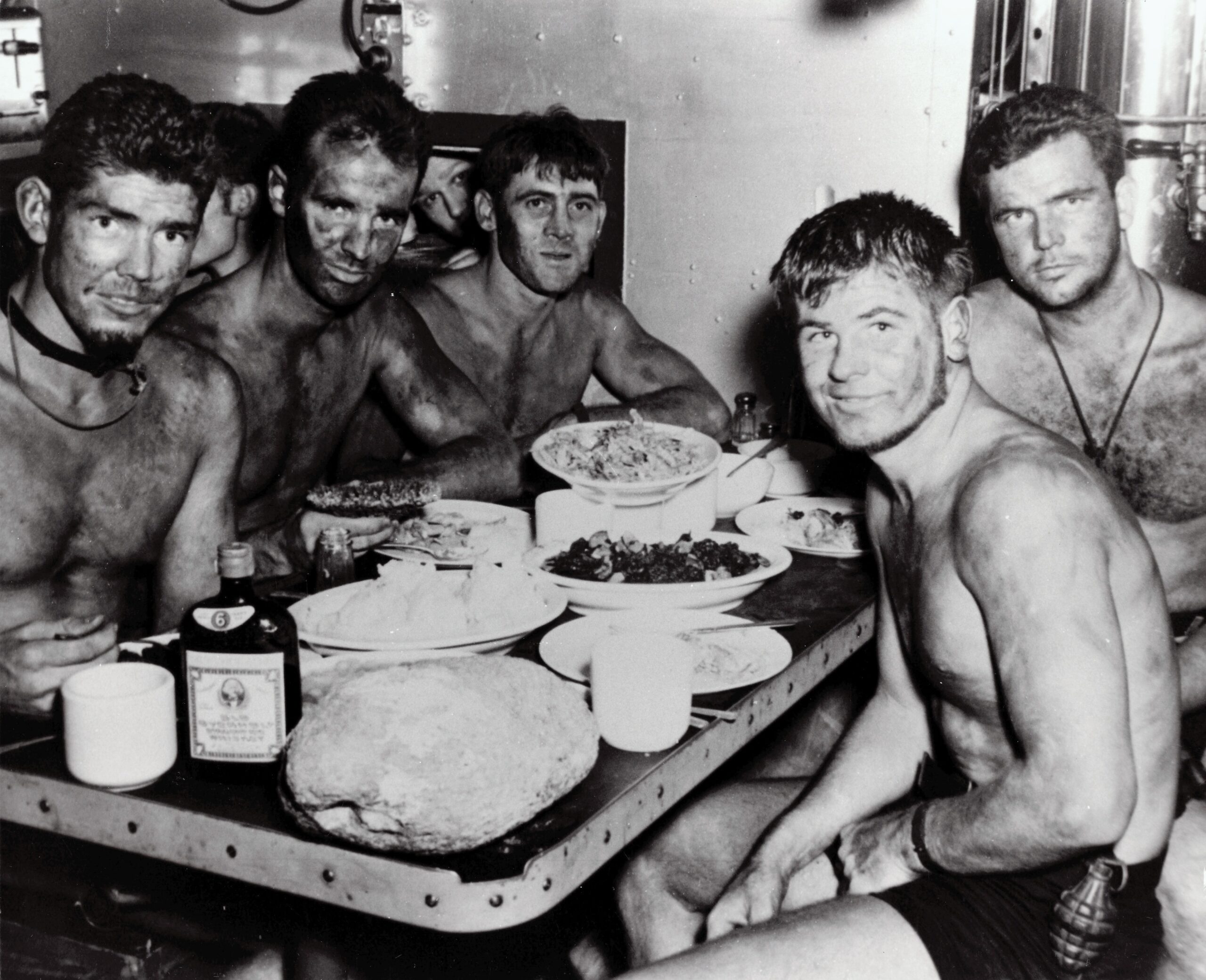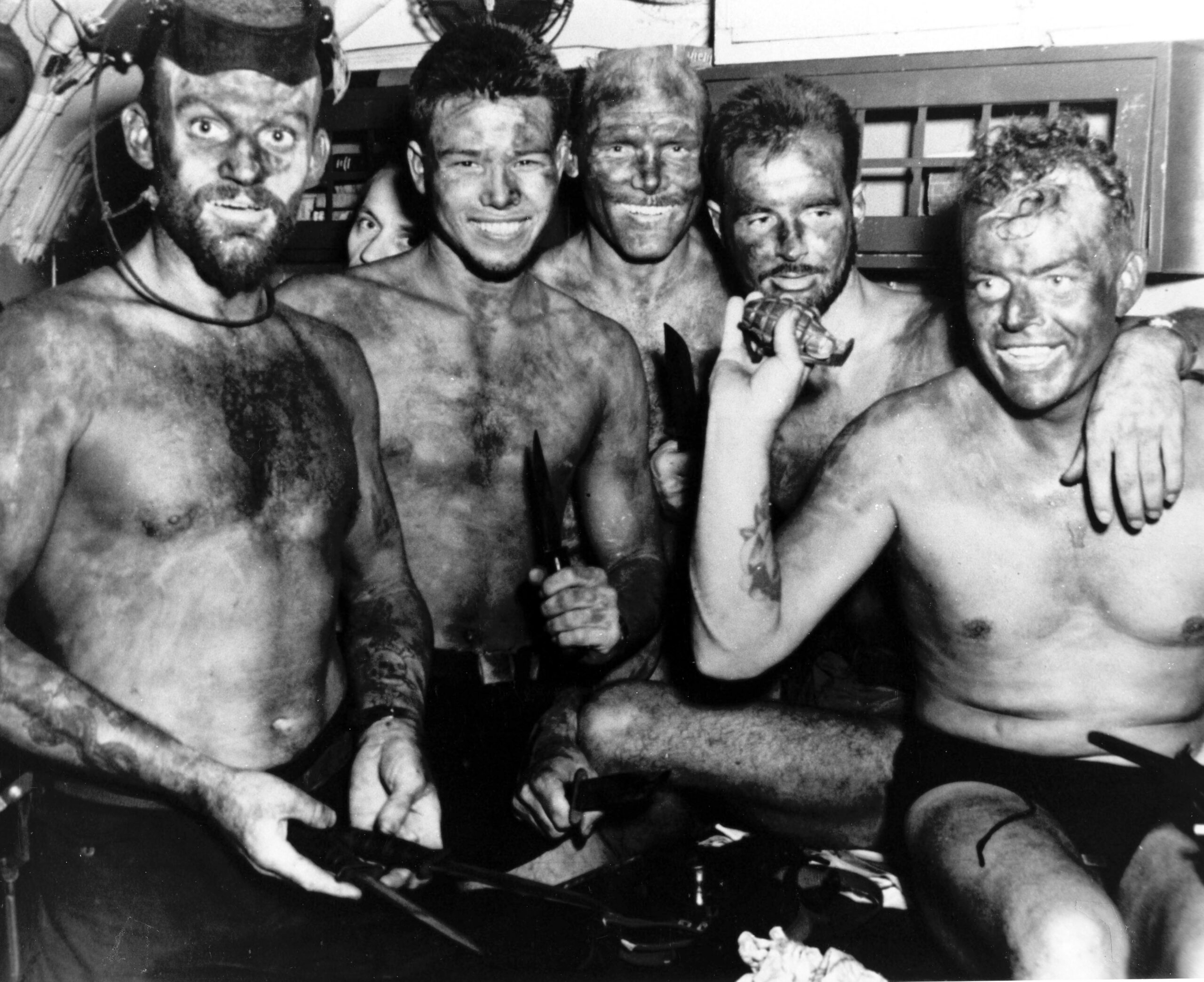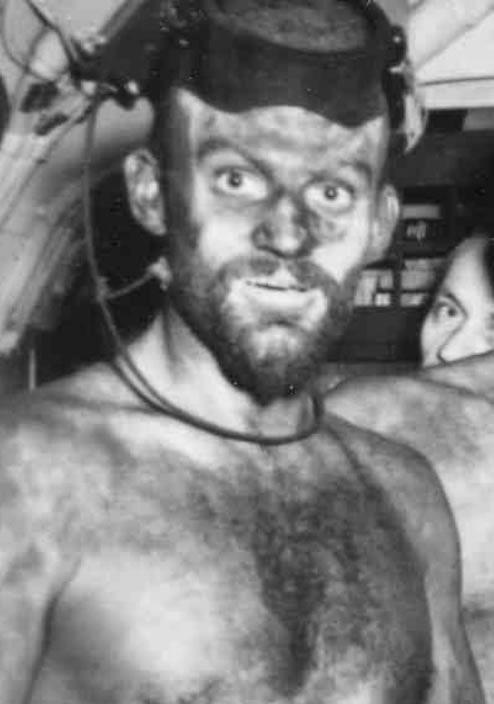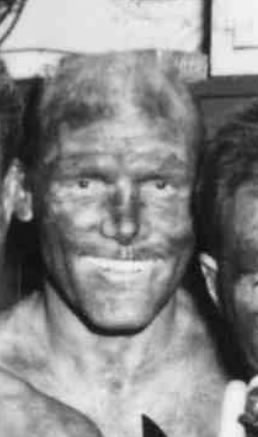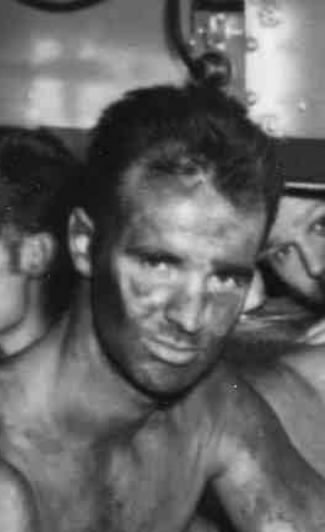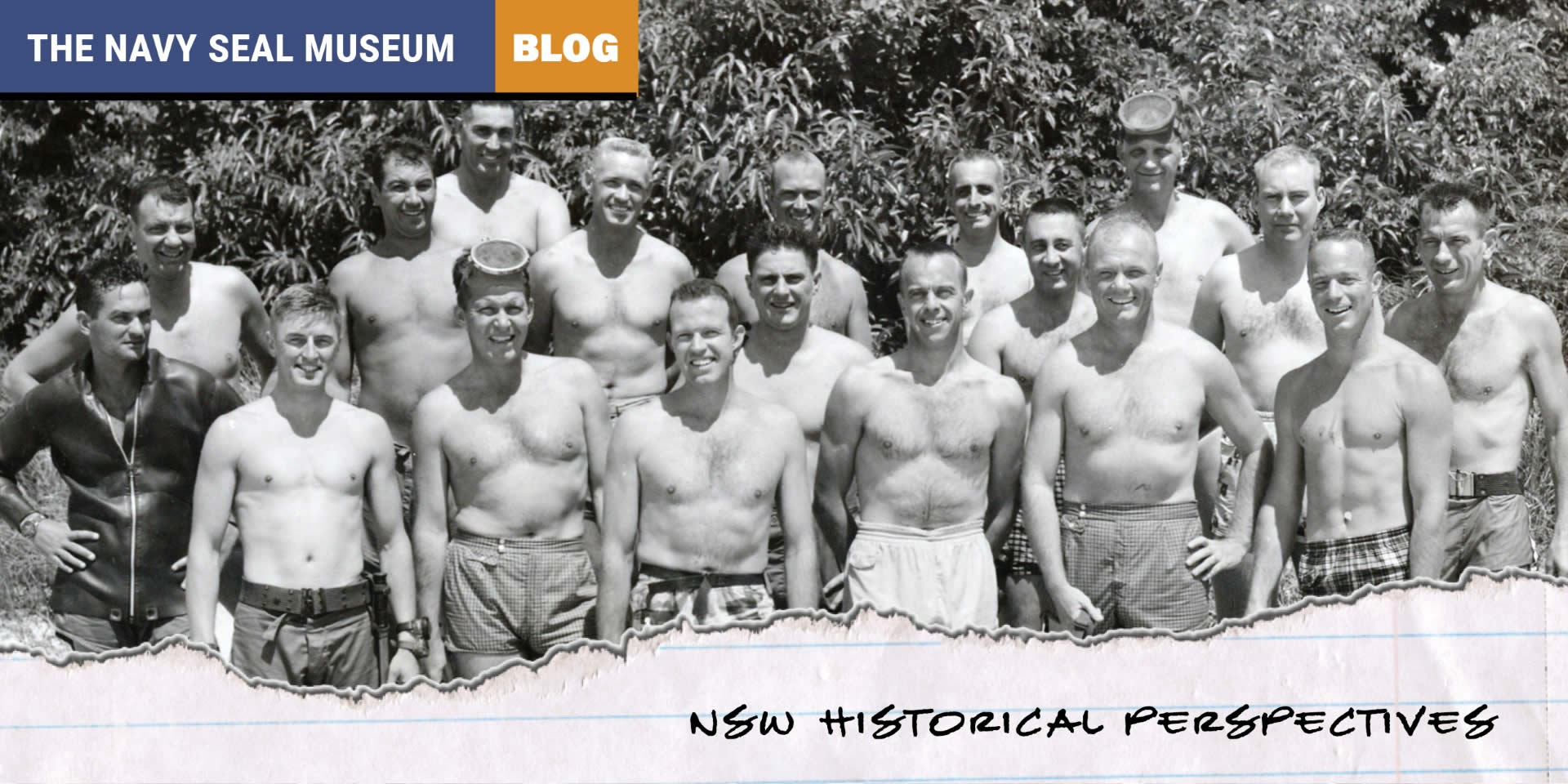
USS Burrfish – UDT Special-Mission Group
Several years ago, Bill Perkins, son of the late Rear Admiral William B. Perkins provided me with a priceless collection of documents which are now at the Navy UDT- SEAL Museum on behalf of the Perkins family. This collection of papers described the Third-War Patrol of the submarine USS Burrfish (SS-312), which occurred during July and August 1944 and included a special-mission reconnaissance of Peleliu, Angau, and Gagil Tomil of the Yap Island Group. At the time, Lieutenant Commander Perkins was commanding officer of Burrfish.
On this patrol, the submarine carried a special-mission detachment of UDT volunteers comprised of men from the Naval Combat Demolition Training and Experimental Base, Maui, T.H. staff and new members of UDT-10, who had been trained by the Office of Strategic Services Maritime Unit (OSS-MU). Bill Perkins related to me that: “My father never referred to these men as UDT, but simply called them “the swimmers.”
This patrol has gained legendary significance in the history of Naval Special Warfare, since it was the first and only submarine-launched reconnaissance operation accomplished by the Pacific UDTs during WWII. It is also the only combat mission ever accomplished by NSW operators, where men were lost in action and their remains never recovered.
Admiral Perkins’ Burrfish records provide a detailed accounting of the UDT mission, but nothing, of course, about the fate of the men after they went missing. Burrfish records, which are acknowledged as conjecture, stated: “After considering all possibilities it is believed that the three men joined up, saw something interesting near the shoreline, decided to investigate and were captured. They must have been on, or very near the shore, as they were much too experienced swimmers for all of them to have been taken in the water. The men were covered with commando black paint and were very difficult to see in the water.”
Here’s What Happened
On 9 July 1944, the UDT men embarked Burrfish for the planned mission. They remained aboard for over one month before undertaking any tasking. The UDT men were LT M.R. Massey; CGM Howard “Red” Roeder; CBM John E. Ball; CM3c Emmet L. Carpenter; QM1c Robert A. Black, Jr.; SP(A)1c John MacMahon; SP(X)1c William Moore; S1c Leonard Barnhill; and QM3c Warren Christensen. (Note: CGM = Chief Gunners Mate; today called GMC or Gunners Mate Chief. CBM = Chief Boatswain Mate; today called BMC or Boatswain Mate Chief.)
On the night of 16 August 1944, the submarine surfaced, and “swimmers” Lieutenant Massy, Warren Christensen, Leonard Barnhill, William Moore, and John MacMahon departed Burrfish and paddled their rubber boat to the near shore and anchored. Lieutenant Massey and three of the UDT men, having been grease-camouflaged, swam onto the reef and back. They determined that discolored patches shown in air photos were only sea grass instead of reeds that could strand a landing craft.
Two nights later, Burrfish surfaced again two miles off the strongly guarded east shore of Yap. Chief Howard Roeder led this mission accompanied by Chief John Ball, Emmet Carpenter, Robert Black, and John MacMahon. They paddled within a quarter mile of shore and found a barrier reef just below the surface. Fearing the breakers might carry the boat ashore; they anchored and left Chief Ball aboard. The other four started swimming toward the shore.
Some fifteen minutes later, Black brought Carpenter back to the boat because of fatigue. Black rejoined MacMahon and Chief Roeder, and they began swimming toward the island. The three men never returned as planned. Ball and Carpenter became worried, and finally decided to hoist anchor and search for their Teammates. They made a sweep along the reef, but there was no sign of the men. Time had run out, and they had to return to Burrfish; hoping against hope that their Teammates had swam directly back to the submarine, but there was no such luck.
The submarine searched close inshore until dawn, when the coming daylight required the ship to submerge and move farther to sea. Later the next morning Burrfish patrolled submerged off the reef in another vain attempt to spot the men. The surviving UDT men pleaded with Commander Perkins to let them go back to the barrier reef that night, being certain the lost men would try to make it after dark. The sea had grown rougher, however, and he made the hard decision that having alerted the Japanese, and already losing three men, he didn’t want to lose more. Burrfish terminated the search for the missing men and began transit for its next patrol event.
In concluding his report, Admiral Perkins stated: “In this officer’s experience, this group of men was outstanding – both professionally and as shipmates. They have had a long and difficult cruise in the submarine but have acquitted themselves admirably. It is a tragedy that Roeder, MacMahon, and Black are not on board.”
Several days later, an intercepted Japanese document revealed the following:
ANNANSAKI 22 August 1944
Special Report GOTTO Unit
Intelligence Office (JOKOSHITSU)
On the 20th we seized three American prisoners at the TOBARU Battery on Yap. They belong to the FIFTH Demolition Unit. These men were transported by submarines. They jumped into the sea at points several miles distant from shore and by swimming reached the reefs off Tobaru Island, Leng and Lebinau. When they tried to return, they lost sight of their submarine and swam back to the seacoast. They were captured while hiding. In view of this situation, we must keep a strict watch especially in regard to infiltration of these various patrols and spies from submarines….
The observations in this documentation indicated that the UDT men gave their Japanese captors a false story; one that they were briefed to provide if needed during pre-mission planning. Post-war research negated a story speculating that they were lost when a Japanese vessel was sunk by the U. S. Navy.
Nothing is really known except that the UDT men gave their lives for their country. Each was posthumously awarded the Silver Star Medal. Their surviving teammates returned to Hawaii in December. Moore, Barnhill, and Christensen joined the Maui training staff, since their team, UDT-10, was already in Hollandia, New Guinea preparing for a fourth-beach mission. These three survivors were also awarded the Silver Star Medal and the right to wear the submarine insignia.
Because of Lieutenant Commander Perkins’ Burrfish report, I learned for the first time that Chief Howard Roeder was not married; his next of kin was his mother Isa G. Roeder of Hollywood, California. Robert Black was married; his wife Ida lived in Glen Rock, New Jersey. John MacMahon was married; his wife’s name was stated simply as Mrs. John C. MacMahon c/o Dr. A.S. Michalson, Minneapolis, Minnesota. If any had children, they would certainly be very proud of their father’s service to their country. It will be a remarkable day if and when these men are ever returned to the land and flag they served, and for which they died so bravely.
USS Burrfish (SS-312)
UDT operators (l-r) Leonard Barnhill, John MacMahon, LT M.R. Massey, Bill Moore, and Warren Christensen on the Mess Deck of USS Burrfish. All were members of UDT-10 or on the UDT training staff at Maui.
Most likely this photo was taken just before the men launched on their special-reconnaissance mission from USS Burrfish (SS-312) at Peleliu on 18 August 1944: (l-r) Chief Howard “Red” Roeder, Emmet L. Carpenter, Bob Black, John MacMahon, and CPO John Ball.
Chief Howard “Red” Roeder
Robert Black
John MacMahon
UDT Men and the BentPropTM Project
Very few have seen the accounting provided by Dr. Patrick J. Scannon, MD, PhD. He is leader of the BentProp Project, which is dedicated to locating and assisting with identifying the remains of American prisoners of war (POW) and missing in action (MIA) from World War II and other conflicts around the world – men who gave their lives in defense of America.
According to Dr. Scannon: “This ‘sinking history’ appears to have been used by the Japanese military in Palau on at least two other occasions as a decoy (documented from War Crimes Tribunal hearings), to hide the Kempeitai (the military police of the Japanese Army) execution of American USAAF airmen and civilian Catholic missionaries. No concrete evidence exists that any American POW ever left the Palau Islands alive, before or after the war.”
Here is what I learned several years ago through correspondence with Dr. Scannon:
“It is both right and timely to inform you that, based on multiple and independent sources from Palau, Japan, and the United States, we have now generally reconstructed what happened to Chief Gunners Mate Howard “Dynamite Joe” L. Roeder, QM1c Robert A. Black, and Sp(A)1c John C. MacMahon.
“Briefly, on 21 August 1944 the Japanese 46th Naval Garrison reported by telegram to Palau command that three members of an American “Naval Combat Demolition Unit” had been captured by soldiers of the Imperial Japanese Army (IJA) on Yap. Two days later, these POWs were taken from Yap by Auxiliary Subchaser #27 to Koror, Palau. Thereafter Palauan eyewitnesses saw two or three “frogmen” in bondage taken from Koror to Babeldaob – more specifically to the headquarters of the 30th Advanced Base Group Kempeitai (military police) on Babeldaob; under the overall command of LTGEN Sadae Inoue (IJA). Their presence at the Babeldaob headquarters was confirmed by a former Japanese intelligence officer in 1947.
“Sadly, evidence strongly supports that in late August 1944, the UDT men were executed by Japanese Army officers (most likely Kempeitai). One Palauan elder has taken us to where he believes the UDT men’s execution / burial area is located. Our search is a work in progress, and we are still far from discovering the exact burial site, given the size of the area described by the Palauan elder and other confounding factors.”
Dr. Scannon related that: “Each of us remains haunted by their journey from the Yap shoreline to Koror, their march in bondage from Koror to Kempeitai headquarters, and finally their last ride in a Japanese staff car. Our searches are the least we can do to honor these brave Americans.”
In our last correspondence (December 2012), Dr. Scannon related to me that: “You can be sure we have not given up on our searches for our missing UDT members. In fact, we have made some progress in narrowing down possible execution sites since we last spoke…It is a slow process, but one that we will not put down, just as you have not.” The search group still has been unable to find the remains of the men.
Readers can learn more about Dr. Pat Scannon and the entire BentProp Project team at: http://www.bentprop.org/ (Now accessed via a link within: https://www.projectrecover.org/)


